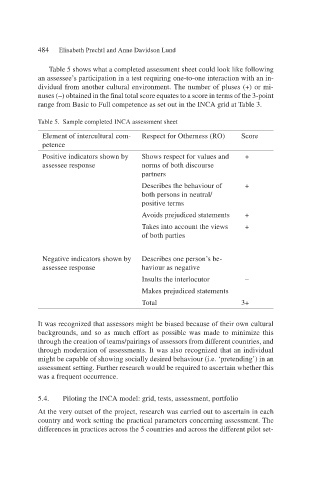Page 506 - Handbooks of Applied Linguistics Communication Competence Language and Communication Problems Practical Solutions
P. 506
484 Elisabeth Prechtl and Anne Davidson Lund
Table 5 shows what a completed assessment sheet could look like following
an assessee’s participation in a test requiring one-to-one interaction with an in-
dividual from another cultural environment. The number of pluses (+) or mi-
nuses (–) obtained in the final total score equates to a score in terms of the 3-point
range from Basic to Full competence as set out in the INCA grid at Table 3.
Table 5. Sample completed INCA assessment sheet
Element of intercultural com- Respect for Otherness (RO) Score
petence
Positive indicators shown by Shows respect for values and 3+
assessee response norms of both discourse
partners
Describes the behaviour of 3+
both persons in neutral/
positive terms
Avoids prejudiced statements 3+
Takes into account the views 3+
of both parties
Negative indicators shown by Describes one person’s be-
assessee response haviour as negative
Insults the interlocutor 3–
Makes prejudiced statements
Total 3+
It was recognized that assessors might be biased because of their own cultural
backgrounds, and so as much effort as possible was made to minimize this
through the creation of teams/pairings of assessors from different countries, and
through moderation of assessments. It was also recognized that an individual
might be capable of showing socially desired behaviour (i.e. ‘pretending’) in an
assessment setting. Further research would be required to ascertain whether this
was a frequent occurrence.
5.4. Piloting the INCA model: grid, tests, assessment, portfolio
At the very outset of the project, research was carried out to ascertain in each
country and work setting the practical parameters concerning assessment. The
differences in practices across the 5 countries and across the different pilot set-

